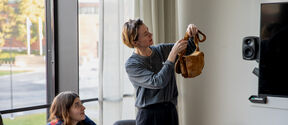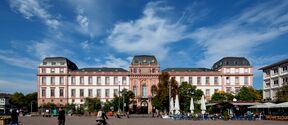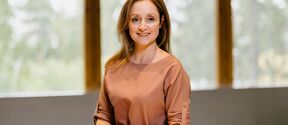Alum Sini Merikallio and the makings of an astronaut

Sini Merikallio happily says yes to my interview request, but asks for a later date.
‘Right now, I’m in a terrible hurry to finish my application to become an astronaut,’ her email explains.
Among other things, the application will require Merikallio to update her LinkedIn profile. Come 2022, she may be able to add the title of astronaut to her space researcher, veterinarian and TV panellist work accomplishments, as the European Space Agency (ESA) is recruiting for the first time in more than a decade. The previous round attracted over 10 000 applications, and Merikallio was included in the final 200.
She expects to receive her licentiate in veterinary medicine before the end of the year, after the thesis examiners have completed their assessment.
‘I’m often asked about my career change, to which I say that I’m not changing careers, just expanding my existing one. It’s not like your background just disappears.’
As her LinkedIn introduction says: Once a planetary scientist, always a planetary scientist.
Tassel-capped animal lover
Sini Merikallio has always been fond of animals. She shared the yard of her childhood home with chickens, horses, a cat and summer piggies. The daughter of a sculptor dad and a painter mum dreamed of being a vet until a passion for physics emerged in her early teens. She devoured popular science books about black holes and the origins of the universe.
Merikallio thought hard between choosing physics or technology. The idea of delving into pure theoretical physics was intriguing, but, on the other hand, Helsinki University of Technology (HUT) students got to don the prestigious tassel cap and, for a keen motorist, perhaps learning how to install nifty extra break lights on her car was also worth considering. This tipped the scales in favour of electrical engineering and space technology studies.
‘Although I never got around to those break lights,’ Merikallio admits.
In addition to academic studies, HUT was a good place for discovering many hobby clubs and societies. Merikallio’s interests were wide-ranging: she participated in the activities of, e.g. the auto racing, aviation, hunting and rugby clubs.
She also took out a student loan, which she used to buy a trotting horse together with two other students. Their horse visited the Otaniemi campus often as part of various events.
‘We trained the horse and I even drove it in a couple of harness races,’ Merikallio says.
Journey to Mars
Her path to becoming one of Finland’s best-known space researchers opened up by chance. During her second year at HUT, Merikallio attended a space technology research seminar where a scientist from the Finnish Meteorological Institute (FMI) gave a lecture on Mars research.
‘I remember thinking, wow, here’s something I’d like to do in the future. Right after the lecture finished, I asked the lecturer how I should go about getting a summer job at the Institute.’
Eventually, she forged a career at the FMI lasting more than a decade. Merikallio has often appeared in the media to comment on space-related topics in addition to participating as a panellist on YLE’s science programmes.
Mars has been a key research subject throughout Merikallio’s career. While finalising her master’s thesis on the behaviour of dust particles in the Martian atmosphere she got as close to her research subject as is possible while still on Earth, becoming the first Finn ever selected to crew the Mars simulator.
The simulator, located in the Utah desert in the USA, is used to conduct two-week field experiments whose participants are required to live like a research team working on the red planet.
‘We exited the research station through an airlock, where you had to wait eight minutes for the “pressure to even out”. While outside, we’d wear space suits and backpacks loaded with rocks to simulate how arduous movement would be. We’d explore the desert on quad bikes – when occasionally coming across some bush or fossil, you’d really imagine that you’d discovered life on Mars!’
What’s so fascinating about the red planet?
‘Mars is relatively nearby. I believe that humans will eventually go there, and this could happen during my lifetime. We’re already sending robots and getting very sharp images from there. It’s exciting to be involved in research that’s constantly yielding fresh knowledge.’
On canine terms
When Merikallio completed her technology doctorate at Aalto University in 2016, she chose a picture of the planet Mars and her dog Eevi for the cover of her thesis.
Labrador retrievers Eevi and Emmi were the reason why she decided to pursue veterinarian studies at the University of Helsinki in 2013.
‘I realised that my dogs would require veterinary assistance within a few years. I could best help them if I myself was the vet.’
This idea had been germinating for some time. Her childhood dream was on her mind right after she completed her master’s thesis, but other interesting job opportunities presented themselves.
‘I remember thinking that I’m too old to alter course, but then I realised that every year I’ll get older, making now the right time. People are at their most efficient when doing something they are truly passionate about.’
She’ll be a fully qualified veterinarian once her licentiate thesis is approved. Its subject is ocular melanoma – a topic once again determined by her dogs, as both of them were afflicted by the disease. Merikallio conducted genetic research to explore the possible hereditary nature of the illness. Her sample size was small, but the study pointed to possible genetic mutations that could be worth further research.
Merikallio received a provisional licence to practice after her fifth year of studies, enabling her to personally perform surgery on her dogs’ eyes and assist her ageing pets to the very end.
‘My perception of what medicine can do and what should be done has changed quite a bit. I believe it gave me at least one year more of shared quality time with my dogs, and, in the end, allowed me to personally perform that final service in our own home.’
From hamsters to bulls
Today, instead of dust particle modelling, Merikallio’s working days are filled with C-sections, tumour removals, dental work and vaccinating puppies. Working as a veterinarian has taken her to more than 20 municipalities all over Finland, helping patients ranging from tiny hamsters to bulls weighing nearly a tonne.
‘The best aspect of veterinary work is its diversity. I do general practice like vaccines and microchipping, but occasionally I’m needed for bigger, demanding operations as well.’
The difference between research work is stark. Whereas researchers can focus on a single topic and work according to their own schedule, vets must live in synch with their clients. They run into unforeseen circumstances and emergencies, a difficult surgery can stretch on and on.
‘The coffee breaks are what I miss most about research work. Gathering around the same table with your colleagues once a day to discuss whatever springs to mind.’
Merikallio can see herself combining the two strands of her career.
‘A lot of tasks require both engineering and medical skills. I could see myself developing medical technology for some company.’
Or perhaps these paths will merge if she becomes an astronaut?
Astronaut spice
We’ll still have to wait a while before we find out whether or not Sini Merikallio becomes the first Finnish astronaut, as ESA’s six-stage application process is scheduled to finish in October 2022.
The candidates whose applications make it to the next stage can look forward to a year of in-depth interviews as well as detailed medical and psychological examinations. In the end, four to six actual astronauts will be chosen in addition to a reserve of twenty or so project astronauts.
Finland is not participating in ESA’s programme of manned flights, which means that a Finn has a better chance of being chosen as a project astronaut than getting on the actual astronaut team. Reservists receive the same basic training and can be invited to specific missions when needed.
‘That would suit me just fine. A little astronaut spice would give my life a great spin!’
Merikallio awaits follow-up news with quiet confidence.
‘I reckon my chances of moving forward are decent.’
ESA is seeking to recruit people with, for example, degrees in science and medicine. Any astronaut would also benefit from the hobbies Merikallio participated in as a tech student: she was an auto racing enthusiast and learned gliding.
‘The enchantment of flying is quite something, everyone at the airfield gives off an aura of happiness.’

Sini Merikallio
- Worked at the Finnish Meteorological Institute researching space and climate change in 1998–2017. Involved in the development of electric solar wind sails, a potential propulsion method for the space craft of the future.
- Veterinarian at Pups ’n Pets Helsinki and Hospital veterinarian at the University of Helsinki. Also provides locum vet services around Finland.
- Panellist on YLE breakfast show’s science-themed segment.
- M.Sc. (Engineering) from Helsinki University of Technology majoring in electrophysics, Doctor of Technology from Aalto University and Bachelor of Veterinary Medicine from the University of Helsinki.
Also…
- A rugby fan: ‘I was the founding chair of the Polytechnic Rugby Club, although we never officially registered the club. Some of the people I played with have gone on to represent Finland. I’ve also used a rugby ball for illustration when presenting my doctoral research, as it employed ovoid dust particle models.’
- Glider pilot: ‘The silence of a glider is mesmerizing. I once flew through an air vortex alongside two birds of prey – that was a fantastic experience.’
- Six Finnish championships in FIA auto slalom: ‘A fast-paced, high-tempo precision discipline that involves driving a street-legal car between gates. My favourite racing rocket was a 1977 Opel Kadett C Coupé. The racing stripe on its side consisted of a sine wave and, instead of the regular GT/E marking, it was marked S/Ni.’
Sini MerikallioPeople are at their most efficient when doing something they are truly passionate about.
Text: Annamari Tolonen
Photos: Aleksi Poutanen
This article was published in the Aalto University Magazine issue 29, October 2021.
Read more news

See Me Make, Make Me See
A Nordic Exploration of Craft, Observation and Language
Aalto academics begin Unite! visiting professorships at TU Darmstadt
As part of the Unite! Visiting Professorship Programme, TU Darmstadt welcomed six visiting professors from Aalto University for the winter semester 2025/2026.
ARTEFAKTI25
ARTEFAKTI returns for the third year at Helsinki Design Week






